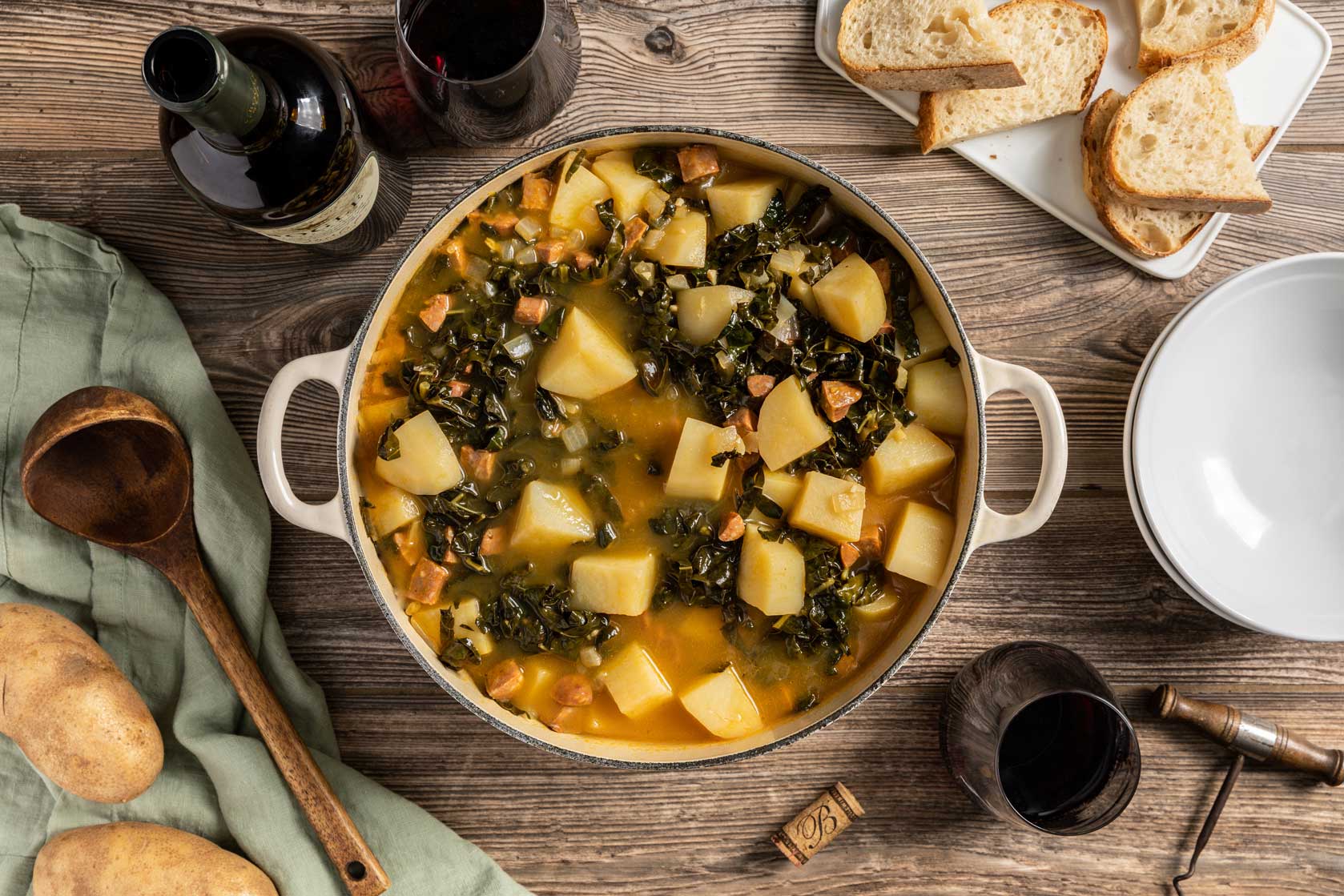Caldo Verde: The Timeless Portuguese Soup with Contemporary
6 min read
Contents
Caldo Verde, a traditional Portuguese soup known for its simplicity and robust flavors, has been a staple in Portuguese cuisine for centuries. Originating from the northern region of Portugal, this dish is a beloved comfort food, often enjoyed during family gatherings, festivals, and as a hearty meal on cold winter nights. Traditionally made with potatoes, kale, chouriço (a type of Portuguese sausage), and olive oil, Caldo Verde is celebrated for its rustic appeal and wholesome ingredients.
In recent years, this classic soup has undergone a transformation, as chefs and home cooks alike experiment with new ingredients, presentation styles, and cooking techniques. This article explores the latest trends and innovations in Caldo Verde, highlighting how this time-honored dish is being reimagined for modern palates while maintaining its essential characteristics.
The Origins of Caldo Verde

Caldo Verde, which translates to “green broth” in English, has its roots in the rural Minho province of northern Portugal. It was originally a humble dish, made with simple ingredients that were readily available to farming families. The soup’s primary ingredient, kale (often referred to as “couve galega” in Portuguese), is a leafy green vegetable that grows abundantly in the region’s fertile soil. Potatoes provide the soup’s creamy base, while chouriço adds a smoky, savory depth of flavor.
Traditionally, Caldo Verde is prepared by simmering thinly sliced kale in a potato-based broth, seasoned with garlic and olive oil. The soup is then topped with slices of chouriço, which impart a distinctive, slightly spicy flavor. This combination of ingredients creates a comforting, nourishing dish that is both simple and satisfying.
Modern Interpretations of Caldo Verde
As with many traditional dishes, Caldo Verde has evolved over time, with modern chefs and home cooks experimenting with new ingredients and techniques to create fresh takes on this classic soup. One of the most notable trends in contemporary Caldo Verde is the incorporation of diverse vegetables and greens, beyond the traditional kale. Spinach, collard greens, and even Swiss chard are being used as substitutes or additions to the classic recipe, adding variety in flavor and texture.
Another modern twist on Caldo Verde involves the use of different types of sausages or even meat substitutes. While chouriço remains a popular choice, some versions now include other smoked sausages like linguiça or even non-Portuguese options like andouille or kielbasa. For those following plant-based diets, vegan chorizo or smoked tofu provide a satisfying alternative that mimics the traditional flavor profile.
The base of the soup is also seeing creative variations. Some chefs are blending in roasted garlic, onions, or leeks to enhance the depth of flavor, while others are experimenting with different types of potatoes, such as sweet potatoes or even cauliflower, to add a unique twist. Additionally, the use of herbs like thyme, bay leaves, or parsley is becoming more common, introducing aromatic elements that complement the soup’s rich, earthy flavors.
Presentation and Pairing Innovations

Presentation plays a significant role in the modern culinary scene, and Caldo Verde is no exception. The traditional way of serving Caldo Verde—piping hot in a rustic bowl with a slice of crusty bread on the side—remains popular. However, contemporary presentations are bringing a new aesthetic to the table.
In upscale restaurants, Caldo Verde is often served in elegant, minimalistic bowls, sometimes garnished with a drizzle of high-quality olive oil or a sprinkle of smoked paprika to add a touch of color and flavor. The kale is often cut into fine ribbons or even flash-fried to add a crispy texture, creating a contrast with the soup’s creamy base. Some chefs also choose to serve the sausage on the side, allowing diners to customize their experience.
Pairing Caldo Verde with complementary dishes and beverages is another area where modern interpretations are shining. While a glass of Vinho Verde—a light, slightly effervescent white wine from northern Portugal—remains a classic pairing, more adventurous pairings are emerging. Craft beers, particularly those with smoky or peppery notes, are increasingly popular accompaniments, as they complement the soup’s flavors without overpowering them. For non-alcoholic options, a sparkling water with a hint of citrus can provide a refreshing contrast to the soup’s richness.
Caldo Verde Goes Global
Caldo Verde has long been a staple of Portuguese cuisine, but in recent years, it has gained international recognition. As Portuguese cuisine becomes more popular worldwide, Caldo Verde is being introduced to new audiences in innovative ways. In cities with vibrant food scenes, like New York, London, and Sydney, Portuguese restaurants and food trucks are offering modern versions of Caldo Verde, often tailored to local tastes and dietary preferences.
In the United States, for example, Caldo Verde has found a place on the menus of fusion restaurants, where it is often reimagined with local ingredients or combined with elements from other culinary traditions. In some versions, the traditional kale is replaced with locally sourced greens like collards or mustard greens, while the chouriço is swapped for American-style smoked sausages or even bacon. These adaptations reflect the dish’s versatility and its ability to resonate with a global audience while still honoring its Portuguese roots.
Moreover, the rise of food blogging and social media has played a significant role in popularizing Caldo Verde beyond Portugal. Food influencers and home cooks from different parts of the world are sharing their unique takes on the soup, experimenting with ingredients and techniques while showcasing the dish’s inherent comfort and flavor. This global exchange of ideas has contributed to the evolution of Caldo Verde, making it a dish that is both rooted in tradition and open to innovation.
Health and Nutritional Aspects

One of the reasons Caldo Verde has remained popular over the years is its health benefits. The soup is naturally nutritious, with kale providing a rich source of vitamins A, C, and K, as well as calcium and antioxidants. Potatoes offer a good balance of carbohydrates and fiber, making the soup filling and satisfying. The olive oil used in Caldo Verde is a healthy fat, rich in monounsaturated fatty acids and known for its heart-protective properties.
As the world becomes more health-conscious, these nutritional aspects of Caldo Verde are being highlighted in modern interpretations. Some versions of the soup are being adapted to fit specific dietary needs, such as gluten-free, low-carb, or low-sodium diets. For example, cauliflower is sometimes used in place of potatoes to create a lower-carb version, while the amount of chouriço can be reduced or replaced with a plant-based alternative to lower the fat and sodium content.
Additionally, the focus on organic and locally sourced ingredients is becoming more prevalent in modern Caldo Verde recipes. Home cooks and chefs alike are prioritizing fresh, seasonal produce, and some are even growing their own kale or herbs to use in the soup. This emphasis on quality ingredients not only enhances the flavor of Caldo Verde but also aligns with current trends towards sustainable and mindful eating.
The Future of Caldo Verde
As Caldo Verde continues to evolve, it remains a beloved dish that bridges the gap between tradition and modernity. The soup’s ability to adapt to new trends while retaining its core identity speaks to hometogel its enduring appeal. Whether enjoyed in a rustic kitchen in Portugal or a trendy restaurant halfway across the world, Caldo Verde offers a comforting taste of Portuguese heritage.
Looking ahead, we can expect to see even more creative interpretations of Caldo Verde as chefs and home cooks continue to experiment with flavors, ingredients, and presentation. The growing interest in global cuisines and the fusion of culinary traditions suggest that Caldo Verde will remain a dynamic and versatile dish, capable of surprising and delighting diners for years to come.
Conclusion
Caldo Verde is much more than just a soup; it is a symbol of Portuguese culture and a testament to the power of simple, quality ingredients. Its evolution from a humble rural dish to a globally recognized culinary icon reflects the adaptability and resilience of traditional foods in the modern world. As Caldo Verde continues to inspire chefs and home cooks alike, its future looks as vibrant and flavorful as the deep green kale that gives it its name. Whether you are a purist who loves the classic recipe or an adventurer eager to try the latest twist, Caldo Verde offers something for everyone—a warm, nourishing bowl of history and innovation.
Read More Article About “Washington’s Wealth: Absolute Influence and Power“






